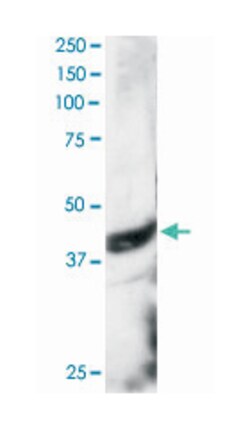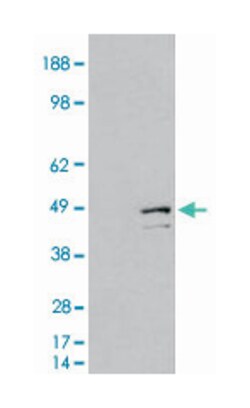Learn More
DAP3, Goat, Polyclonal Antibody, Abnova™
Goat polyclonal antibody raised against synthetic peptide of DAP3.
Supplier: Abnova Corporation PAB6163
Description
Mammalian mitochondrial ribosomal proteins are encoded by nuclear genes and help in protein synthesis within the mitochondrion. Mitochondrial ribosomes (mitoribosomes) consist of a small 28S subunit and a large 39S subunit. They have an estimated 75% protein to rRNA composition compared to prokaryotic ribosomes, where this ratio is reversed. Another difference between mammalian mitoribosomes and prokaryotic ribosomes is that the latter contain a 5S rRNA. Among different species, the proteins comprising the mitoribosome differ greatly in sequence, and sometimes in biochemical properties, which prevents easy recognition by sequence homology. This gene encodes a 28S subunit protein that also participates in apoptotic pathways which are initiated by tumor necrosis factor-alpha, Fas ligand, and gamma interferon. This protein potentially binds ATP/GTP and might be a functional partner of the mitoribosomal protein S27. Splice variants that differ in the 5' UTR have been found for this gene; both variants encode the same protein. Pseudogenes corresponding to this gene are found on chromosomes 1q and 2q. [provided by RefSeq]
Sequence: NPSLLERHCAYLSpecifications
| DAP3 | |
| Polyclonal | |
| Unconjugated | |
| ELISA (1:16000) Western blot (1-3 ug/mL) The optimal working dilution should be determined by the end user. | |
| DAP3 | |
| DAP-3/DKFZp686G12159/MGC126058/MGC126059/MRP-S29/MRPS29/bMRP-10 | |
| Goat | |
| Antigen affinity purification | |
| RUO | |
| 7818 | |
| Human | |
| Liquid |
| ELISA, Western Blot | |
| 0.5 mg/mL | |
| Goat polyclonal antibody raised against synthetic peptide of DAP3. | |
| In Tris saline, pH 7.3 (0.5% BSA, 0.02% sodium azide) | |
| NP_387506.1;NP_004623.1 | |
| DAP3 | |
| A synthetic peptide corresponding to human DAP3. | |
| 100 μg | |
| Primary | |
| This antibody is expected to recognize both human isoforms of this protein. | |
| Store at -20°C. Aliquot to avoid repeated freezing and thawing. |
Your input is important to us. Please complete this form to provide feedback related to the content on this product.
For Research Use Only

